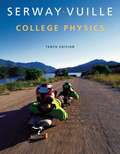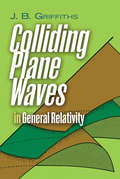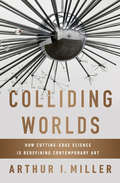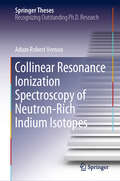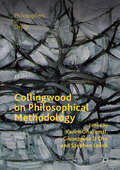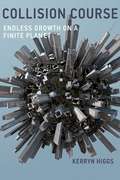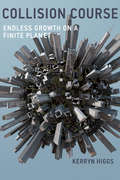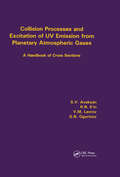- Table View
- List View
College Physics AP®
by Alan Van Heuvelen Eugenia Etkina Michael GentileThis correlates the College Board's Advanced Placement® Physics Curriculum Framework (effective Fall 2014) to the corresponding chapters and sections in College Physics, AP Edition.
College Physics Essentials, Eighth Edition: Electricity and Magnetism, Optics, Modern Physics (Volume Two)
by Jerry D. Wilson Anthony J. Buffa Bo LouThis new edition of College Physics Essentials provides a streamlined update of a major textbook for algebra-based physics. This is the second volume covers electricity, atomic, nuclear, and quantum physics. The first volume is available separately and covers topics such as mechanics, heat, and thermodynamics. The authors provide emphasis on worked examples together with expanded problem sets that build from conceptual understanding to numerical solutions and real-world applications to increase reader engagement. Including over 900 images throughout the two volumes, this textbook is highly recommended for students seeking a basic understanding of key physics concepts and how to apply them to real problems.
College Physics Essentials, Eighth Edition: Mechanics, Thermodynamics, Waves (Volume One)
by Jerry D. Wilson Anthony J. Buffa Bo LouThis new edition of College Physics Essentials provides a streamlined update of a major textbook for algebra-based physics. This is the first volume and covers topics such as mechanics, heat, and thermodynamics. The second volume available separately, covers electricity, atomic, nuclear, and quantum physics. The authors provide emphasis on worked examples together with expanded problem sets that build from conceptual understanding to numerical solutions and real-world applications to increase reader engagement. Including over 900 images throughout the two volumes, this textbook is highly recommended for students seeking a basic understanding of key physics concepts and how to apply them to real problems.
College Physics For AP® Courses
by Irina Lyublinskaya Gregg Wolfe Douglas Ingram Liza Pujji Sudhi Oberoi Nathan CzubaThe AP Physics Collection is a free, turnkey solution for your AP® Physics course, brought to you through a collaboration between OpenStax and Rice Online Learning. The integrated collection features the OpenStax College Physics for AP® Courses text, Concept Trailer videos, instructional videos, problem solution videos, and a correlation guide to help you align all of your free content. The College Physics for AP® Courses text is designed to engage students in their exploration of physics and help them apply these concepts to the Advanced Placement® test. This book is Learning List-approved for AP® Physics courses
College Physics Tenth Edition
by Raymond A. Serway Chris VuilleWhile physics can seem challenging, its true quality is the sheer simplicity of fundamental physical theories--theories and concepts that can enrich your view of the world around you. COLLEGE PHYSICS, Tenth Edition, provides a clear strategy for connecting those theories to a consistent problem-solving approach, carefully reinforcing this methodology throughout the text and connecting it to real-world examples. For students planning to take the MCAT exam, the text includes exclusive test prep and review tools to help you prepare.
College Physics for the AP® Physics 1 Course
by Roger Freedman Gay Stewart Todd Ruskell Philip KestenNIMAC-sourced textbook <P><P>College Physics for the AP® Physics 1 Course is the first textbook to integrate AP® skill-building and exam prep into a comprehensive college-level textbook, providing students and teachers with the resources they need to be successful in AP® Physics 1. Throughout the textbook you’ll find AP Exam Tips, AP® practice problems, and complete AP® Practice Exams, with each section of the textbook offering a unique skill-building approach. Strong media offerings include online homework with built-in tutorials to provide just-in-time feedback. College Physics provides students with the support they need to be successful on the AP® exam and in the college classroom.
College Physics for the AP® Physics 1 Course
by Roger Freedman Gay Stewart Todd Ruskell Philip KestenCollege Physics for the AP® Physics 1 Course is the first textbook to integrate AP® skill-building and exam prep into a comprehensive college-level textbook, providing students and teachers with the resources they need to be successful in AP® Physics 1. Throughout the textbook you’ll find AP Exam Tips, AP® practice problems, and complete AP® Practice Exams, with each section of the textbook offering a unique skill-building approach. Strong media offerings include online homework with built-in tutorials to provide just-in- time feedback. College Physics provides students with the support they need to be successful on the AP® exam and in the college classroom.
College Physics: A Strategic Approach
by Randall D. Knight Brian Jones Stuart FieldThis book is a new algebra-based physics textbook for students majoring in the biological and life sciences, architecture, natural resources, and other disciplines.
College Physics: A Strategic Approach
by Randall D. Knight Brian Jones Stuart FieldForce and Motion Conservation Laws Properties of Matter Oscillations and Waves Problems Optics Electricity and Magnetism Modern Physics
College Physics: A Strategic Approach
by Brian Jones Stuart Field Randall KnightCollege Physics: A Strategic Approach, 4th Edition expands its focus from how mixed majors students learn physics to focusing on why these students learn physics. The authors apply the best results from educational research and Mastering™ Physics metadata to present basic physics in real world examples that engage students and connect physics with other fields, including biological sciences, architecture, and natural resources. From these connections, students not only learn in research-driven ways but also understand why they are taking the course and how it applies to other areas.
College Physics: A Strategic Approach (AP Edition)
by Randall KnightBuilding on the research-proven instructional techniques introduced in Knight's Physics for Scientists and Engineers, College Physics: A Strategic Approach, 3/e has set a new standard for algebra-based introductory physics, gaining widespread critical acclaim from professors and students alike. The text and MasteringPhysics work together to help physics students see the big picture, gain crucial problem-solving skills, and better prepare for both their lecture and future. -- www.pearsonhighered.com
College Physics: Explore And Apply
by Alan Van Heuvelen Eugenia Etkina G. PlaninsicCollege Physics Explore and Apply
College Physics: Putting It All Together
by Jeff Adams Ron Hellings Greg Francis<p>An algebra-based physics text designed for the first year, non-calculus college course. Although it covers the traditional topics in the traditional order, this book is very different from its competitors. This textbook is a ground-breaking iconoclast in this market, answering a clear demand from physics instructors for a clearer, shorter, more readable textbook. <p>College Physics: Putting it all together includes: A clear and streamlined narrative - when the authors break away to introduce a worked example, it is introduced in the text and is directly related to the subject preceding it. Telling the students what they need to know to solve the homework and test problems without a lot of unnecessary puffery. Keeping students engaged with a friendly and even occasionally humorous writing style, and droll illustrations. Handling common student misconceptions in difficult topics by weaving them into the narrative. Retaining key textbook elements that are truly useful, such as worked examples, summaries and plenty of chapter-ending problems.</p>
Collider Physics (Frontiers in Physics)
by Vernon D. BargerThis updated edition of Collider Physics surveys the major developments in theoretical and experimental particle physics and uses numerous illustrations to show how the Standard Model explains the experimental results. Collider Physics offers an introduction to the fundamental particles and their interactions at the level of a lecture course for graduate students, with emphasis on the aspects most closely related to colliders--past, present, and future. It includes expectations for new physics associated with Higgs bosons and supersymmetry. This resourceful book shows how to make practical calculations and serves a dual purpose as a textbook and a handbook for collider physics phenomenology.
Collider Physics within the Standard Model: A Primer (Lecture Notes in Physics #937)
by Guido Altarellijames WellsThis book is open access under a CC BY 4.0 license.With this graduate-level primer, the principles of the standard model of particle physics receive a particular skillful, personal and enduring exposition by one of the great contributors to the field. In 2013 the late Prof. Altarelli wrote: The discovery of the Higgs boson and the non-observation of new particles or exotic phenomena have made a big step towards completing the experimental confirmation of the standard model of fundamental particle interactions. It is thus a good moment for me to collect, update and improve my graduate lecture notes on quantum chromodynamics and the theory of electroweak interactions, with main focus on collider physics. I hope that these lectures can provide an introduction to the subject for the interested reader, assumed to be already familiar with quantum field theory and some basic facts in elementary particle physics as taught in undergraduate courses. “These lecture notes are a beautiful example of Guido’s unique pedagogical abilities and scientific vision”. From the Foreword by Gian Giudice
Colliding Plane Waves in General Relativity (Dover Books on Physics)
by J. B. GriffithsThis monograph surveys recent research on the collision and interaction of gravitational and electromagnetic waves. "This is a particularly important topic in general relativity," the author notes, "since the theory predicts that there will be a nonlinear interaction between such waves." Geared toward graduate students and researchers in general relativity, the text offers a comprehensive and unified review of the vast literature on the subject.The first eight chapters offer background, presenting the field equations and discussing some qualitative aspects of their solution. Subsequent chapters explore further exact solutions for colliding plane gravitational waves and the collision and interaction of electromagnetic waves. The final chapters summarize all related results for the collision of plane waves of different types and in non-flat backgrounds. A new postscript updates developments since the book's initial 1991 publication.
Colliding Worlds: How Cutting-Edge Science Is Redefining Contemporary Art
by Arthur I. MillerA dazzling look at the artists working on the frontiers of science. In recent decades, an exciting new art movement has emerged in which artists utilize and illuminate the latest advances in science. Some of their provocative creations--a live rabbit implanted with the fluorescent gene of a jellyfish, a gigantic glass-and-chrome sculpture of the Big Bang (pictured on the cover)--can be seen in traditional art museums and magazines, while others are being made by leading designers at Pixar, Google's Creative Lab, and the MIT Media Lab. In Colliding Worlds, Arthur I. Miller takes readers on a wild journey to explore this new frontier. Miller, the author of Einstein, Picasso and other celebrated books on science and creativity, traces the movement from its seeds a century ago--when Einstein's theory of relativity helped shape the thinking of the Cubists--to its flowering today. Through interviews with innovative thinkers and artists across disciplines, Miller shows with verve and clarity how discoveries in biotechnology, cosmology, quantum physics, and beyond are animating the work of designers like Neri Oxman, musicians like David Toop, and the artists-in-residence at CERN's Large Hadron Collider. From NanoArt to Big Data, Miller reveals the extraordinary possibilities when art and science collide.
Collinear Resonance Ionization Spectroscopy of Neutron-Rich Indium Isotopes (Springer Theses)
by Adam Robert VernonThis thesis describes the application of the collinear resonance laser spectroscopy to sensitively measure the electromagnetic nuclear observables of the neutron-rich indium isotopes 115-131In. This entailed a systematic study of the efficiency of resonant ionization schemes to extract the hyperfine structure of the isotopes, the atomic charge exchange process and benchmarking of modern atomic calculations with a laser ablation ion source. This allowed determination of the root-mean-square nuclear charge radii, nuclear magnetic dipole moments, nuclear electric quadrupole moments and nuclear spins of the 113-131In isotopes with high accuracy. With a proton hole in the Z = 50 nuclear shell closure of tin and several nuclear isomer states, these measurements of the indium (Z = 49) isotope chain provided an efficient probe of the evolution of nuclear structure properties towards and at the doubly-magic nuclear shell closure of 132Sn (N = 82) - revealing unpredicted changes.
Collingwood on Philosophical Methodology (Philosophers in Depth)
by Stephen Leach Karim Dharamsi Giuseppina D'OroThis book discusses Collingwood's conception of the role and character of philosophical analysis. It explores questions, such as, is there anything distinctive about the activity of philosophizing? If so, what distinguishes philosophy from other forms of inquiry? What is the relation between philosophy and science and between philosophy and history? For much of the twentieth century, philosophers philosophized with little self-awareness; Collingwood was exceptional in the attention he paid to the activity of philosophizing. This book will be of interest both to those who are interested in Collingwood’s philosophy and, more generally, to all who are interested in the question ‘what is philosophy?’
Collision Course
by Kerryn HiggsThe story behind the reckless promotion of economic growth despite its disastrous consequences for life on the planet.
Collision Course: Endless Growth on a Finite Planet (The\mit Press Ser.)
by Kerryn HiggsThe story behind the reckless promotion of economic growth despite its disastrous consequences for life on the planet.The notion of ever-expanding economic growth has been promoted so relentlessly that “growth” is now entrenched as the natural objective of collective human effort. The public has been convinced that growth is the natural solution to virtually all social problems—poverty, debt, unemployment, and even the environmental degradation caused by the determined pursuit of growth. Meanwhile, warnings by scientists that we live on a finite planet that cannot sustain infinite economic expansion are ignored or even scorned. In Collision Course, Kerryn Higgs examines how society's commitment to growth has marginalized scientific findings on the limits of growth, casting them as bogus predictions of imminent doom.Higgs tells how in 1972, The Limits to Growth—written by MIT researchers Donella Meadows, Dennis Meadows, Jorgen Randers, and William Behrens III—found that unimpeded economic growth was likely to collide with the realities of a finite planet within a century. Although the book's arguments received positive responses initially, before long the dominant narrative of growth as panacea took over. Higgs explores the resistance to ideas about limits, tracing the propagandizing of “free enterprise,” the elevation of growth as the central objective of policy makers, the celebration of “the magic of the market,” and the ever-widening influence of corporate-funded think tanks—a parallel academic universe dedicated to the dissemination of neoliberal principles and to the denial of health and environmental dangers from the effects of tobacco to global warming. More than forty years after The Limits to Growth, the idea that growth is essential continues to hold sway, despite the mounting evidence of its costs—climate destabilization, pollution, intensification of gross global inequalities, and depletion of the resources on which the modern economic edifice depends.
Collision Phenomena in Liquids and Solids
by Alexander L. Yarin Cameron Tropea Ilia V. RoismanA comprehensive account of the physical foundations of collision and impact phenomena and their applications in a multitude of engineering disciplines. In-depth explanations are included to reveal the unifying features of collision phenomena in both liquids and solids, and to apply them to disciplines including theoretical and applied mechanics, physics and applied mathematics, materials science, aerospace, mechanical and chemical engineering, and terminal ballistics. Covering a range of examples from drops, jets, and sprays, to seaplanes and ballistic projectiles, and detailing a variety of theoretical, numerical, and experimental tools that can be used in developing new models and approaches, this is an ideal resource for students, researchers, and practicing engineers alike.
Collision Processes and Excitation of UV Emission from Planetary Atmospheric Gases: A Handbook of Cross Sections
by SV AvakyanOver the past few decades, the excitation and ionization of atmospheric gases has become an area of intense research. A large amount of data have been accumulated concerning the various elementary processes which occur when photons, electrons and ions collide with atoms and molecules. This scattered information has now been collected in a handbook for the first time, and the authors give a critical analysis of relevant data. This book is a comprehensive and detailed study of the available information and is distinguished by the following outstanding features: the consideration of a large number of atmospheric constituents, including H^O2, H, N^O2, N, O^O2, O, CO, CO^O2, H^O2O, HCl and some hydrocarbons the maximum number of space particles, including magnetospheric particles, are considered as projectiles: photons, electrons, hydrogen atoms, protons and helium ionsthe energy range under study corresponds to the real spectrum of cosmic fluxes, from threshold values for elementary processes up to several thousand keV the recommended values of cross sections, obtained from analysis of the available experimental data, are given in the handbook and their accuracy is estimated. These features make the handbook particularly valuable to specialists in the aeronomy of planets, comets and active perturbations, as well as to experimentalists and theoreticians working in the fields of plasma physics, atomic and molecular physics, physics of the upper atmosphere, chemical physics, optics and spectroscopy.













